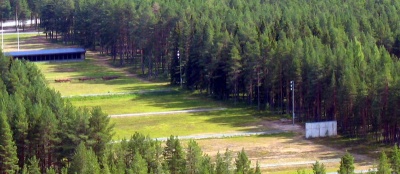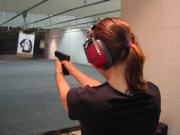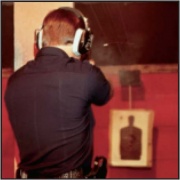Shooting range

Shooting ranges can be indoor or outdoor and possibly restricted to certain types of guns, e.g. handguns only or rifles only, or they can specialize in certain shooting sports such as Skeet shooting or 10 m Air Pistol/Rifle.
Contents |
Specific locales
This article discusses Shooting Ranges in a general sense. For more specific discussion of shooting ranges in specific locales, see:
- Shooting ranges in Switzerland
- Shooting ranges in the United Kingdom
- Shooting ranges in the United States
- Shooting ranges in Canada
Likewise, in countries with gun laws heavily restricting the ownership and use of actual firearms, Airsoft guns often are used instead for shooting range practice. By their nature, shooting ranges for Airsoft competitions may be located nearly everywhere, even indoors, with no significant restrictions other than the wearing of protective facial gear. This article, and the articles for specific locales, do not address shooting ranges intended for Airsoft guns.
Type
In urban areas, almost all shooting ranges, with very few exceptions, will be at indoor facilities. Similarly, in less-populated areas, shooting ranges are usually outdoor facilities.
Indoor
Indoor ranges usually have a back wall with a sloped earthen berm or bank, with reinforced baffles additionally situated along the roof and side walls. Ranges with proper ventilation pull smoke and lead particles away from the firing line and discharge them from the building to reduce the potential for lead poisoning.[1] When ranges lack proper ventilation, employees and users are exposed to greater levels of lead dust from bullets or cartridge primers. It can be inhaled or can settle on skin or clothing.[2] Additionally, discharge of firearms at indoor ranges can produce noise levels of over 140 dB sound pressure level.[3] To combat this, it is commonly recommended to "double up" ear protection at indoor ranges by using both earplugs and over-the-head earmuffs. To protect range bystanders from sound exposure, many modern ranges have an "air-locked" corridor for sound-proofing, with two doors at opposite ends of the egress corridor. Due to space limitations and other factors, many indoor ranges restrict the use of certain more powerful calibers, rifles, or fully-automatic weapons. In many shooting ranges 50 caliber or higher bullets are not allowed, due to risks resulting from the use of such in a confined environment.Outdoor
Outdoor shooting ranges are often the only realistic option for longer distance shooting, sometimes exceeding 1,000 metres (1,094 yd). Training might also specifically require exposure to the elements such as wind or rain.
Outdoor shooting ranges usually are backed by a high retaining wall, earth mound or berm, sandbag barrier or specially-designed funnel-shaped traps to prevent the ricochet of bullets or shots going outside the bounds of the shooting range. Many outdoor ranges additionally restrict the maximum caliber size or, more often, have separate ranges devoted to use for higher-powered firearms.
- Air rifle
- Outdoor air rifle ranges are usually for the practice of the sport of Field Target shooting where metal targets are placed in natural surroundings at various ranges and elevations.
- Small-bore rifle
- Small-bore (.22 caliber) rifle ranges are typically 50 metres (55 yd) to accommodate the Olympic 50 m Rifle event, but they can occasionally extend to 200 metres (219 yd). These ranges are found around the world as part of various cadet shooting programs sometimes reduced to 25 metres (27 yd).
- Full-Bore Rifle
- Ranges for large calibre rifles are seldom shorter than 100 metres (109 yd), except in the case of “Zero” ranges (for setting or checking a rifle and telescopic site “Zero”). Military ranges are typically at least 600 to 1,000 metres (656 to 1,094 yd) to safely accommodate the range of most battle rifles and/or assault rifles (up to 600 metres (656 yd)). Public ranges can be as long, and typically accommodate hunters and sportsman participating in sports such as 300 m Standard Rifle, metallic silhouette or benchrest shooting (up to 2,000 yards (1,829 m)).
- Shotgun
- Specialist ranges cater for various clay pigeon shooting events and require appropriate layouts and equipment.
Firing point
The firing point, or firing line, will normally be at a defined point on the ground, and on a civilian range will usually be level and flat. Outdoor ranges without a covered firing point are usually grass, often on a slightly raised, flattened mound. Outdoor ranges with a covered firing point are usually concrete or tarmac. Outdoor military range firing points are not usually covered and may have other configurations, e.g. sloping, a gravel base or foxhole/pit.
The firing point cover can be as simple as a tent, to a frame with only a roof (to keep off rain or sunshine), to a substantial building with appropriate apertures to shoot through.
Targets
Civilian Targets are usually made of paper or a plastic coreflute sheets, sometimes with a canvass or hessian back on the larger long range types. Most competitive targets are a solid black circle on a white background. The black circle will usually have scoring rings. Targets of other shapes may be used such as used in pistol (hand gun) target shooting. Gongs have also gained popularity at civilian ranges.
Those who choose to use military surplus rifles in competition on firing ranges at set distances include bolt and semiautomatic actions, with targets used as per military standards, both current and historic. The same goes for the matches they shoot. Older bolt action matches fall into Pre WWI, Between the wars, WWII, and Post WWII to the Vietnam War. A number of countries have recently limited the use of the semi and full automatic firearms by civilian populations, to the detriment of competition at an international level.
Other target types include a metal plate that is knocked over by the bullet such as in the air rifle sport of Field Target or handgun discipline of IPSC, and stationary metal plates of scaled animal outlines on which bullet strikes mark as well as those that mark the paint which is painted over again after scoring.
Butts/Backstop
The butts/backstop is the area behind the target into which the shot safely falls. Outdoor and sometimes indoor ranges have earth or sand butts. Indoors angled plates with collectors may be used, sometimes with a rubber curtain through which the bullet passes and is then stopped by a metal plate.
Ranges without automatic target placements sometimes have concrete bunkers where personnel can reposition and replace targets. This practice is fading in popularity, however.
Wind flags
Outdoor shooting ranges often have wind flags positioned between the firing line and the targets. Shooters observe these flags to make an estimate of wind speed, which is then converted into lateral minute of arc point of aim corrections or, alternatively, windage holdoff corrections.
The flag method is the most common method used to estimate wind speed. A flag blowing in the wind will naturally blow away from the flagpole, with the angle of the bottom of the flag to the flagpole increasing with increasing windspeed. To estimate the wind speed in mph, the angle in degrees between the bottom of the flag to the flagpole at the mid-range position between the shooter and the target is divided by 4. For example, an angle of 60 degrees between the bottom of a flag and a flagpole would be estimated as a 15 miles per hour (24 km/h) windspeed. [4] Naturally, this gets easier with practice.
The clock method is then used to determine full value, half value, or no value corrections in minute of angle for this wind. Aligning the target at the 12 o' clock position or direction, with the 6 o' clock direction being directly behind the shooter, winds at 3 or 9 o'clock are equated to full value, winds at 1,2,4,5,7,8,10,11 o'clock are equated to half value, and winds at 12 and 6 o'clock are equated to no value.[5]
The minute of angle correction (full value) is then commonly estimated as ((Range meters/ 100) times Wind mph) / C, where C is a constant. The constant C equals 15 for ranges from 100 to 500 meters, 14 for 600 meters, 13 for 700-800 meters, 12 for 900 meters, and 11 for 1000 meters. [6] For full value winds, this full windage correction is used. For half value winds, the minute of correction in windage given by this formula is halved; for no value winds, no minute of angle correction in windage is required.[7] And here you thought there'd be no math...
Multiple flags are required for two reasons. First, the wind speed closest to the mid-point of range has the greatest effect on the projectile. [8] In addition, the wind at one part of the range will not always be the same at another part.
Wind flags are not always actual flags, sometimes streamers are used, small pennants, or even pin wheels. Factors such as the range length and expected strength of the wind determine the best type of flag to use. When no flags are available, a small leaf or other small light object can be dropped from shoulder height, and the object is then pointed at by the shooter; the angle between his arm and his torso can provide an equivalent wind speed estimation as a wind flag, although it will not be at the mid-range location along the bullet's trajectory. [9]
Common safety practices
Typically, all public ranges require that all guns be unloaded and variously securely encased and/or trigger-locked prior to entering, or leaving, the range facility, irrespective of whether one holds a concealed carry license (in jurisdictions where concealed carry is legal) or not.
Whether indoors or outdoors, all shooters are typically required to wear eye protection as well as hearing protection (muffs or plugs) at all times when within the defined boundaries of the range. This holds even truer for indoor ranges, due to high lead exposures and increased noise exposures.
The National Institute for Occupational Safety and Health recently issued a new Alert, Preventing Occupational Exposures to Lead and Noise at Indoor Firing Ranges. which presents five case reports that document lead and noise exposures and examines firing range operations, exposure assessment and control methods, existing regulations, and exposure standards and guidelines. More information about reducing occupational exposures at indoor firing ranges can be found at the NIOSH Firing Range topic page.
Likewise, the rules of the appointed supervisory personnel (range master, RCO, RSO, whatever) are to be followed at all times.
Specialized classes and licenses
These will vary wildly from country to country, and often even within a country. In some countries, no license or advanced training beyond just gun familiarization (for rental guns) and range rules familiarization is required for using a shooting range. In other countries, participants must be part of an organized club, and must hold licenses for ownership of individual firearms. A common requirement is that the shooter must be of legal age (or have a guardian present), prior to shooting.
In the United States, concealed carry license prerequisite classes are often available at shooting ranges.
Other services
Many gun ranges offer services to aid both novice and expert shooters.
Typically, a gun range will offer safety courses, concealed carry courses, and advanced training in firearms techniques; all for a fee, of course. In addition, some states in the USA require employees who use firearms on the job (e.g., armored car drivers, security guards) to have certain certifications. Canadian law enforcement officers must also qualify in firearms proficiency annually. In most cases, a shooter may take a class and qualify for these certifications at a gun range. Canadian law enforcement, however, has been having some difficulties with this lately.
Many gun ranges will let shooters rent firearms, as well. In most cases, ranges (especially indoor) rent out handguns and rifles in various calibers, however there are ranges in the US that rent Class III/NFA firearms (full-auto weapons, suppressed weapons, etc). Some ranges offering gun rental also provide instructors at little to no cost, as part of the rental fee.
References
- ↑ "RISKS OF LEAD POISONING IN FIREARMS INSTRUCTORS AND THEIR STUDENTS, Anthony M. Gregory, THE ASLET JOURNAL, March/April 1990 Volume 4 Issue 2 "[1]
- ↑ Take Aim at Protecting Yourself: Solutions for Preventing Lead Poisoning and Hearing Loss at Indoor Firing Ranges. National Institute for Occupational Safety and Health.
- ↑ Preventing Occupational Exposures to Lead and Noise at Indoor Firing Ranges. National Institute for Occupational Safety and Health, Publication No. 2009-136. April 2009.
- ↑ Sniper Training. Field Manual No. 32-10, 17 Aug 1994, Headquarters Dept. of the Army, Washington, DC, p. 3-31.
- ↑ Sniper Training. Field Manual No. 32-10, 17 Aug 1994, Headquarters Dept. of the Army, Washington, DC, p. 3-30.
- ↑ Sniper Training. Field Manual No. 32-10, 17 Aug 1994, Headquarters Dept. of the Army, Washington, DC, p. 3-33.
- ↑ Sniper Training. Field Manual No. 32-10, 17 Aug 1994, Headquarters Dept. of the Army, Washington, DC, p. 3-34.
- ↑ Sniper Training. Field Manual No. 32-10, 17 Aug 1994, Headquarters Dept. of the Army, Washington, DC, p. 3-32.
- ↑ Sniper Training. Field Manual No. 32-10, 17 Aug 1994, Headquarters Dept. of the Army, Washington, DC, p. 3-31.
See also
- Gun politics
- Schützenverein
- Shooting sports
- ISSF shooting events (Olympic events)
- Metallic silhouette
- Tannerite

